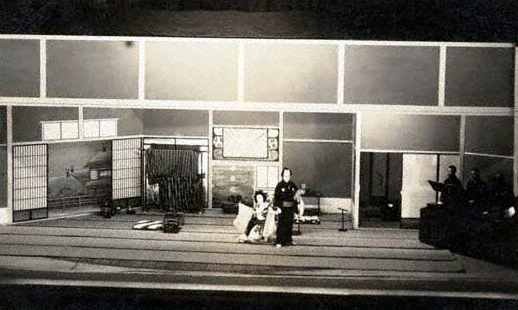| GONGE |
| Play titles | Hiyoku no Ch˘ Haru no Soga Giku Sono Kouta Yume mo Yoshiwara That Song and a Dream of Yoshiwara [1] |
|||||||||||||
| Common titles | Gonge Gonpachi Komurasaki |
|||||||||||||
| Author | Fukumori Kiusuke | |||||||||||||
| History |
"Gonpachi Komurasaki" was premiered in the 1st lunar month of 1816 in Edo at the Nakamuraza as the first and second acts of the nibanme of the sogamono "Hiyoku no Ch˘ Haru no Soga Giku" [more details]. This new year drama mixed two sekai: it was a sogamono and a gonpachi-komurasakimono. "Gonge" is the nickname of the second act. The accompanying music, performed in the Kiyomoto style, "Gonge" is the nickname of the first act. Gon came from Gonpachi, the first name of the hero. Ge came from shita no maki, which means the lower (shita; ge is another possible reading) volume (maki), aka the second act. became famous and its own title, "Sono Kouta Yume mo Yoshiwara", quickly became the title of these two acts, which were kept in the Kabuki repertoire. The others acts related to the vendetta of the Soga brothers fell into oblivion. |
|||||||||||||
| Structure |
"Gonge" (2nd act), which is less popular than "Gonj˘" (first act), and it is always staged with "Gonj˘". "Gonge" is made up of two scenes: |
|||||||||||||
|
||||||||||||||
| Key words |
Ageya Gonpachi-komurasakimono Hirai Gonpachi Kiyomoto Koto Kouta Kuruwa Maegami Miuraya Komurasaki Rokug˘gawa Seppuku Sewamono Shakuhachi Shin-Yoshiwara Shirai Gonpachi Torite Yoshiwara |
|||||||||||||
| Summary |
Shin-Yoshiwara Miuraya Komurasaki Heya Shirai Gonpachi is in Komurasaki's room at the Miuraya, a famous ageya in the pleasure quarter of Shin-Yoshiwara, playing his bamboo shakuhachi to the accompaniment of Komurasaki's koto. Suddenly, one of the strings on the koto snaps and this is traditionally a bad omen. Gonpachi, remembering his frightening dream [2], cannot help feeling perturbed. Shirobŕ, the proprietor of the Miuraya, who is sympathetic to the lovers, comes to the room. Komurasaki quickly hides her lover in an adjoining room while she asks Shirobŕ what business it is that has brought him to her room. Shirobŕ answers that he is aware that Gonpachi comes often to meet her, but he has heard that he is wanted for murder and theft. He kindly warns Komurasaki of the danger in Gonpachi's frequenting her quarters, and hints that she must quickly send Gonpachi on his way so that he will not be caught by the law. Komurasaki thanks Shirobŕ for his consideration. The Miuraya proprietor is aware of the presence of Gonpachi in the next room and he makes his departure. Gonpachi, who has overheard Shirobŕ's words, dashes out in a frenzy. Komurasaki tells him that she has been more or less aware of the circumstances from the many rumors going around the quarters. Gonpachi says that his nightmare [2] will no doubt come true. Komurasaki promises him that she will remain true to her pledge and stay with him to death. But before fleeing together, it is necessary to change Gonpachi's appearance so that he will not be readily recognized. Komurasaki brings out her mirror and starts to arrange his hair in a different style so as to alter his appearance. She shaves off his front lock of hair (maegami). But even as she does so, torite rush into the room. Rokug˘gawa Gonpachi Tachibara Gonpachi comes in his flight in the dead of night to the Rokug˘ River where there is a small ferryboat. He calls into the boatman's shack to ask for passage across the river. But it turns out that the boatman is a torite in disguise. In a moment Gonpachi is surrounded by a group of torite, and rather than be taken and executed, he commits suicide by self-disembowelment (seppuku). |
|||||||||||||
| Notes |
[1] The title "That Song and a Dream of Yoshiwara" comes from Samuel Leiter's "Historical Dictionary of Japanese Traditional Theatre". [2] Scene 1 in "Gonj˘". |
|||||||||||||
 |
|
The actors Onoe Baik˘ VI and Ichimura Uzaemon XV playing the roles of Miuraya Komurasaki and Shirai Gonpachi in the "Komurasaki Heya" scene of the drama "Sono Kouta Yume mo Yoshiwara", which was staged in November 1925 at the Imperial Theater |
|
|
| Contact | Main | Top | Updates | Actors | Plays | Playwrights | Programs | Links | FAQ | Glossary | Chronology | Illustrations | Prints | Characters | Derivatives | Theaters | Coming soon | News |